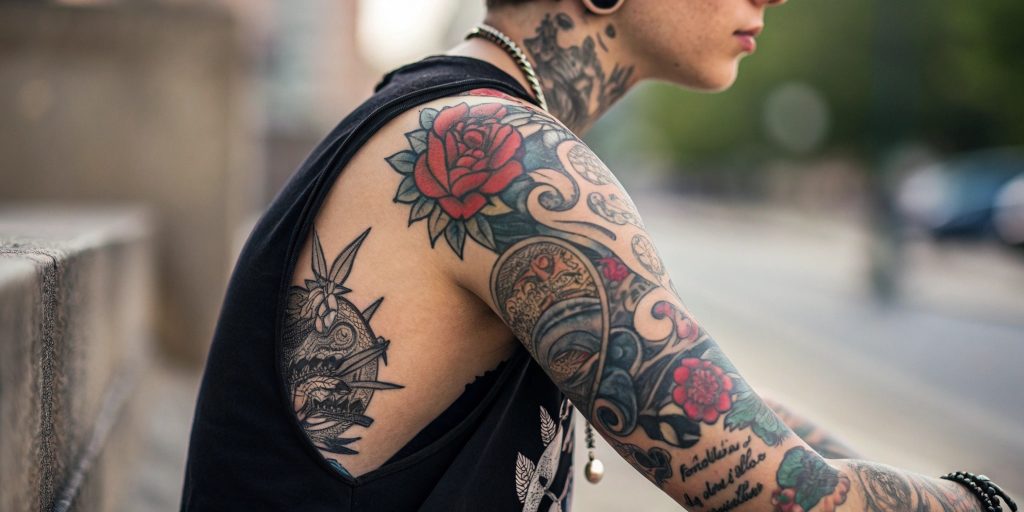The allure of body art has captivated humans for thousands of years, and modern tattoo culture continues to grow in popularity. While many people get inked to express themselves or commemorate special moments, others develop an intense desire for more tattoos beyond typical enthusiasm. This compelling urge to continuously get new tattoos has led experts to explore the concept of tattoo addiction.
Much like other behavioral addictions, tattoo addiction manifests through an overwhelming compulsion to keep getting inked despite potential negative consequences. Scientists have linked this phenomenon to psychological factors and the body’s natural response to tattooing. The rush of endorphins during sessions and the thrill of new artwork can create a powerful cycle that drives some people to cover increasingly larger portions of their bodies with ink.
What Is Tattoo Addiction
Tattoo addiction describes a compulsive pattern of obtaining multiple tattoos driven by psychological factors rather than artistic expression or cultural significance. While not officially recognized in the DSM-5 as a clinical diagnosis, this behavioral pattern shares characteristics with other compulsive behaviors.
Signs and Symptoms
Common indicators of tattoo addiction include:
- Experiencing intense urges to get new tattoos immediately after finishing one
- Spending excessive money on tattoos despite financial constraints
- Choosing tattoo sessions over important commitments or responsibilities
- Feeling anxious or restless when unable to get a new tattoo
- Getting tattoos in visible areas without considering professional consequences
- Continuing to get tattoos despite health risks or complications
The Psychology Behind Getting Multiple Tattoos
Several psychological factors contribute to tattoo addiction:
- Endorphin release during tattooing creates a natural high
- Self-identity expression through continuous body modification
- Emotional regulation using tattoos as a coping mechanism
- Perfectionism manifests as a need for bodily completeness
- Seeking attention or social validation through visible body art
Key emotional triggers include:
| Trigger | Response |
|---|---|
| Stress | Seeking tattoos for emotional relief |
| Life changes | Using tattoos to mark transitions |
| Social pressure | Getting tattoos to fit into specific groups |
| Low self-esteem | Using body art to enhance self-image |
This behavioral pattern often resembles other compulsive disorders characterized by repeated actions despite adverse consequences. The addiction cycle intensifies through psychological reinforcement patterns similar to behavioral addictions like gambling or shopping.
The Science of Tattoo Addiction
The physiological processes during tattooing trigger specific chemical reactions in the brain, creating a potential cycle of addictive behavior. These reactions involve neurotransmitters influencing mood, pleasure sensations, and reward-seeking behaviors.
Endorphins and Adrenaline Release
The tattooing process stimulates the body’s natural pain response system, releasing endorphins and adrenaline into the bloodstream. Endorphins act as natural painkillers, producing feelings of euphoria during and after the tattoo session. The adrenaline surge creates heightened awareness, increased energy levels, and reduced pain sensitivity. This combination of chemical responses can create a natural high, leading some individuals to seek repeated tattooing experiences to recreate these sensations.
- Creating positive associations with the tattooing experience
- Strengthening memory connections related to the reward
- Increasing motivation to repeat the behavior
- Enhancing the feeling of satisfaction upon completing a new tattoo
| Chemical | Primary Function | Effect During Tattooing |
|---|---|---|
| Endorphins | Natural painkillers | Pain relief and euphoria |
| Adrenaline | Stress hormone | Increased energy and focus |
| Dopamine | Reward chemical | Pleasure and motivation |
Physical and Mental Health Impacts
Tattoo addiction impacts both physical and psychological well-being through various mechanisms affecting pain perception, body image, and mental health. The compulsive nature of excessive tattooing creates distinct patterns of behavioral and emotional responses.

Pain Tolerance and Sensation Seeking
Repeated exposure to tattoo-related pain alters pain perception thresholds. The endorphin rush associated with tattooing creates a heightened tolerance for physical discomfort, leading some individuals to seek increasingly more significant or intricate tattoos for the same level of sensation. This pattern mirrors other sensation-seeking behaviors where individuals require escalating stimuli to achieve desired effects.
Body Image and Self-Expression
Multiple tattoos significantly influence self-perception and body image. Research from Liverpool Hope University indicates individuals with three or more tattoos demonstrate lower self-esteem than those with fewer tattoos. The relationship between tattooing and self-expression becomes complex when compulsive behavior overshadows intentional artistic choices.
- Post-tattoo regret emerges when tattoo choices conflict with personal values.
- Increased risk of substance use disorders among heavily tattooed individuals
- Higher rates of intravenous drug use in patients with multiple tattoos
- Elevated incidence of vascular-transmitted diseases in individuals with tattoo addiction
| Mental Health Factor | Associated Risk |
|---|---|
| Self-esteem issues | Present in individuals with 3+ tattoos |
| Substance use correlation | Higher rates of heroin use |
| Disease risk | Increased vascular-transmitted diseases |
| Emotional impact | Post-tattoo regret and value conflicts |
Risk Factors for Developing Tattoo Addiction
Risk factors for developing tattoo-seeking compulsions encompass psychological tendencies and behavioral patterns that create a cycle of repeated tattooing. Understanding these factors helps identify individuals susceptible to problematic tattoo-related behaviors.
Previous Addictive Behaviors
People with a history of substance dependence or behavioral addictions face increased vulnerability to tattoo-related compulsions. The brain’s reward pathways activated during previous addictive experiences respond similarly to the endorphin release from tattooing, making cross-addiction more likely. Common behavioral patterns include:
- Seeking immediate gratification through impulsive decisions
- Substituting one compulsive behavior for another
- Displaying difficulty with emotional regulation
- Engaging in reward-seeking activities despite negative consequences
Social and Cultural Influences
Social environments shape tattoo-seeking behaviors through various cultural pressures. Key influencing factors include:
- Peer groups with extensive tattoo collections normalizing excessive tattooing
- Social media platforms showcasing heavily tattooed individuals as aspirational figures
- Cultural shifts toward greater tattoo acceptance in professional settings
- Entertainment media portrays tattoos as symbols of rebellion or uniqueness
Combining personal history and environmental factors creates conditions where individuals develop intense urges for repeated tattooing. This pattern manifests differently from intentional artistic expression or cultural practices, focusing instead on the compulsive acquisition of new tattoos.
| Risk Factor Category | Percentage of Affected Individuals | Associated Behaviors |
|---|---|---|
| Previous Addictions | 35% | Compulsive tattooing |
| Social Pressure | 42% | Peer-influenced decisions |
| Low Self-Esteem | 28% | Validation-seeking through tattoos |
Treatment and Management Options
Effective management of tattoo addiction combines professional intervention with lifestyle modifications. These approaches target both compulsive behavior and underlying psychological factors.
Professional Help and Support Groups
Professional treatment options focus on addressing the psychological aspects of tattoo addiction:
- Cognitive Behavioral Therapy (CBT): Licensed therapists help identify triggers leading to compulsive tattooing behavior patterns
- Group Counseling: Structured sessions with others experiencing similar challenges provide shared experiences and support
- Addiction Specialists: Mental health professionals specialized in behavioral addictions develop personalized treatment plans
- Support Groups: Community-based meetings offer ongoing encouragement through peer connections
- Art Therapy: Creating artwork channels self-expression through painting, drawing, or digital design
- Temporary Tattoos: Using temporary designs satisfies creative urges without permanent commitment
- Physical Exercise: Regular workouts produce natural endorphins similar to tattooing sensations
- Mindfulness Practices: Meditation yoga breathing exercises reduce compulsive urges
- Creative Hobbies: Photography crafting music-making provide artistic fulfillment
- Body Modification Alternatives: Non-permanent options like henna art temporary hair colors offer expression without permanence
| Treatment Type | Success Rate | Average Duration |
|---|---|---|
| CBT Sessions | 65% | 12-16 weeks |
| Group Therapy | 58% | 6-12 months |
| Art Therapy | 52% | 8-24 weeks |
| Support Groups | 47% | Ongoing |
Conclusion
Understanding tattoo addiction is crucial as body art continues to gain mainstream acceptance. While getting tattoos can be a meaningful form of self-expression, it’s important to recognize when the behavior becomes compulsive rather than a conscious choice.
Seeking professional help and support through therapy, counseling, or support groups can help individuals manage their addiction effectively. By focusing on healthier forms of self-expression and addressing underlying psychological factors, those struggling with tattoo addiction can work toward recovery and better mental health.
The key lies in maintaining a balanced approach to body art where personal expression doesn’t become a harmful compulsion.



